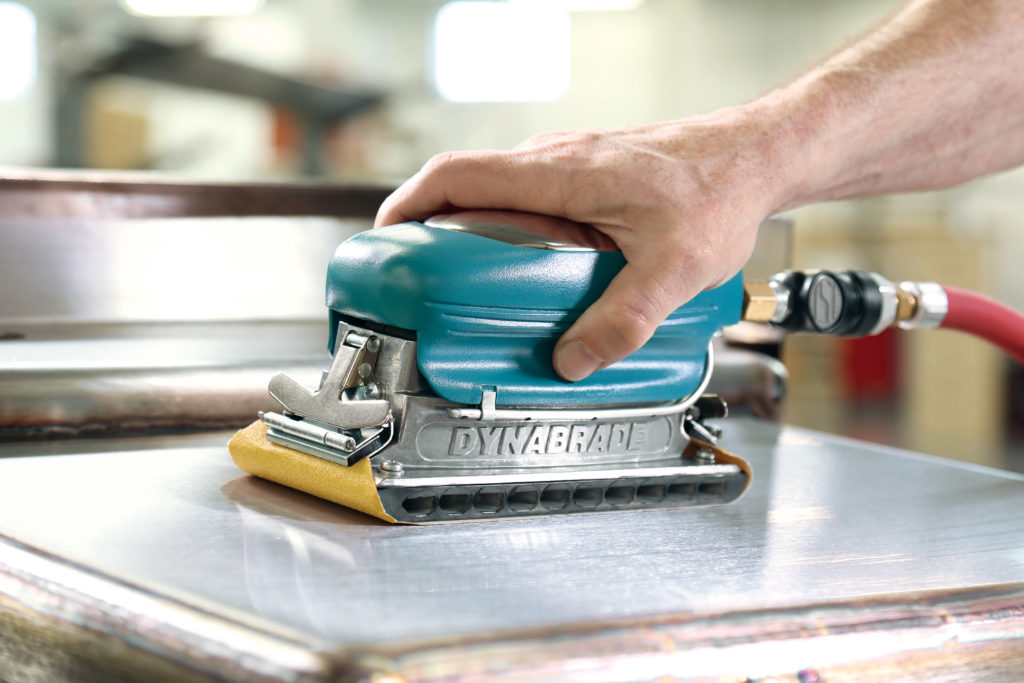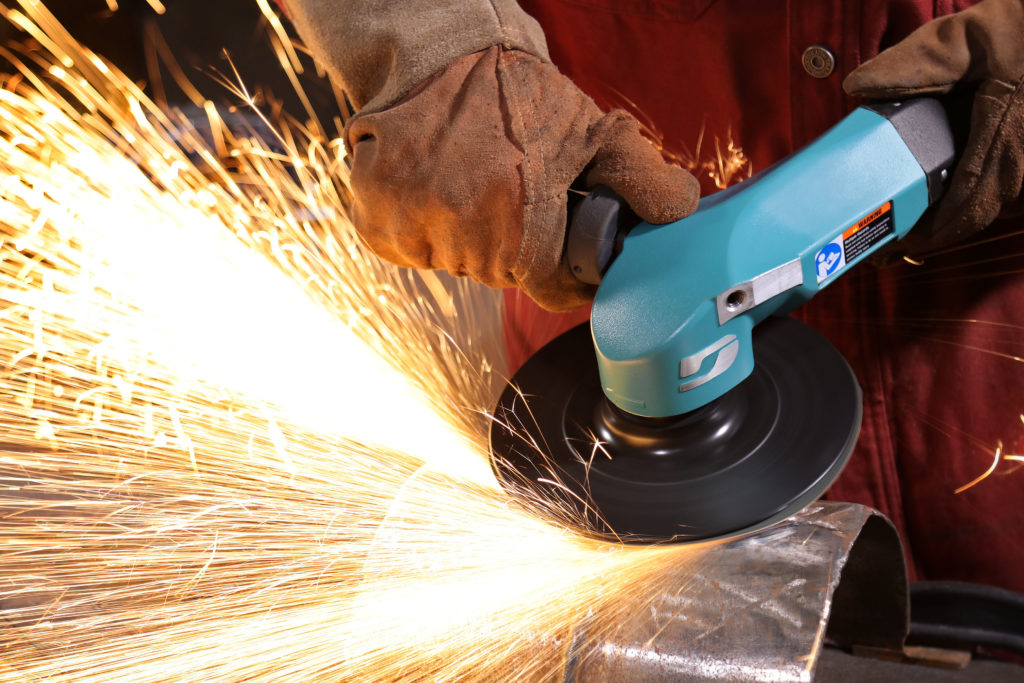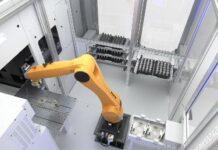Whether you are a metalworker, woodworker, or you work with paints or solid surface materials; developing a process for a given application can be challenging. In the deburring and finishing arena factors like oddly shaped parts, specific tolerances, and environmental factors can all present their own unique obstacles.
 These factors can hinder production, necessitate rework, or even influence an operator’s health and ultimately negatively a manufacturer’s productivity and output. Dynabrade takes a systematic approach to solving difficult applications by listening to manufacturers and observing how their application is currently being done before making recommendations that will optimize their process for maximum productivity, repeatability and safety.
These factors can hinder production, necessitate rework, or even influence an operator’s health and ultimately negatively a manufacturer’s productivity and output. Dynabrade takes a systematic approach to solving difficult applications by listening to manufacturers and observing how their application is currently being done before making recommendations that will optimize their process for maximum productivity, repeatability and safety.
Methods of Deburring
Simply put, deburring is the process of removing from a workpiece unwanted/leftover pieces of material created by a mechanical operation, like grinding, drilling or cutting. Burrs are often found along edges, around drill holes or are left over from a cutting operation and should be removed prior to finishing. When burrs are not removed they can interfere with the seating of a fastener, promote corrosion, cause excess friction in an assembly or interfere with the finishing stages of your process.
Some of the most common methods for removing burrs are grinding, sanding, and wire brushing. These methods are favored for their simplicity, cost effectiveness and because results can be seen & inspected immediately. Removing burrs by grinding is typically done rapidly and aggressively using a bonded abrasive or carbide burrs attached to angle or die grinder to break a burr free from the substrate. This method is very common in heavy-duty applications where large burrs or very hard materials need deburring.
 Sanding is also an effective method for removing burrs and is typically accomplished using a disc sander, abrasive belt tool or orbital sander. Abrasive belt tools, like the Dynafile®, are uniquely suited for deburring applications because they can access recessed areas & narrow openings unlike a disc sander and use abrasives efficiently. Sanding typically utilizes coated or non-woven abrasives in a variety of shapes and sizes, and is less aggressive, and safer than grinding. A hidden benefit to sanding is that it can make your subsequent finishing steps easier to complete because a more uniform surface is normally left behind after sanding when compared to grinding.
Sanding is also an effective method for removing burrs and is typically accomplished using a disc sander, abrasive belt tool or orbital sander. Abrasive belt tools, like the Dynafile®, are uniquely suited for deburring applications because they can access recessed areas & narrow openings unlike a disc sander and use abrasives efficiently. Sanding typically utilizes coated or non-woven abrasives in a variety of shapes and sizes, and is less aggressive, and safer than grinding. A hidden benefit to sanding is that it can make your subsequent finishing steps easier to complete because a more uniform surface is normally left behind after sanding when compared to grinding.
Brushing is typically performed with wire wheels, cups and end brushes or by using abrasive coated filament wheels attached to angle grinders or die grinders. A major benefit in using a wire brush in a deburring application is that the overall part profile will remain unchanged, due to the conformability of the wire as you deburr unlike grinding and sanding that can gouge workpieces. Additionally, wire brushes excel in cylindrical applications where the inside diameter of a tube needs deburring as well as deburring in recessed areas. Wire brushes can be extended into a pipe or bore using an extended die grinder or mandrel to quickly deburr hard to reach areas.
Once the deburring steps in an application have been completed the next challenge begins, finishing. The variety of finishes created in industrial applications is broad with each type having its own purpose from aesthetic to functional. An example of an aesthetic finish is a brushed or satin finish also known as a #4 architectural finish. Functional finishes often seek to improve the ability for two materials like a coating and substrate to bond or adhere to each other. One common, functional process is finishing iron or carbon steel to what is known as a #7 finish prior to chrome plating.
Prep and Final Finish
Finishing requires a great deal of precision and attention to detail; with particularly efficient processes being guarded as trade secrets. While there are many steps to finishing, two major categories encapsulate the overall process, preparation and final finishing. As with deburring many methods for creating a desired finish on metals are available, but how many steps are involved varies depending on the starting condition of the material. Handling marks, scratches, pits or other imperfections all need to be addressed in the preparation steps to create a uniform surface prior to final finishing.
The preparation steps to a finishing process, particularly on metals, often involve “rough” sanding which establishes a consistent base to work from. Commonly, 60 or 80 grit coated abrasives are a good starting point for removing surface imperfections like pits or scratches from handling with grits progressing to 320 or higher as the finish requirements become more stringent. A tool with a linear action should be used to “set a grain” in these steps, not a radial tool like a disc sander. Radial motion tools can gouge and create an arc that will present additional challenges later in the finishing process. It is crucially important to understand how tool speed influences this step – slower tools create deeper, longer scratches while faster tools create shallow, shorter scratches.
This means that when starting with material that has deep scratches, pits or corrosion a tool running more slowly and using coated abrasives will be more efficient at getting below imperfections. Conversely, if the unfinished material is free of pits and deep scratches finer abrasives running on faster tools can be employed for a finishing process with potentially fewer steps. The Dynastraight series of tools range in speed from 950 -6,000 rpm for exactly this purpose.
Once a uniform base is established it is common practice to then use non-woven abrasives – medium, fine, superfine – to blend and smooth the surface, leaving progressively finer lines and a uniform appearance. Some processes end here with the desired finish having been attained or having reached an acceptable point where a final coating can be applied. Other processes require additional polishing or buffing steps to bring the workpiece to its final finish, for instance a #8 or mirror finish. Creating such fine finishes often adds additional steps beyond using non-woven abrasives. Cotton buffing wheels or wool and synthetic fiber belts & wheels are used in combination with several polishing compounds to remove all surface imperfections in a series of steps leading to a final polish. When developing a process including deburring, preparation and final finishing stages it is critical to be consistent and not skip steps. Skipping steps often leads to rework which not only increases the time and effort put into a project, but causes increased wear on tooling, causes abrasive usage to increase, and impacts the person completing the task. If a process is in place but there is room for improvement, partnering with an industry expert like Dynabrade can show how to eliminate steps in a process, make efficient use of abrasives and improve an operator’s working environment.
When developing a process including deburring, preparation and final finishing stages it is critical to be consistent and not skip steps. Skipping steps often leads to rework which not only increases the time and effort put into a project, but causes increased wear on tooling, causes abrasive usage to increase, and impacts the person completing the task. If a process is in place but there is room for improvement, partnering with an industry expert like Dynabrade can show how to eliminate steps in a process, make efficient use of abrasives and improve an operator’s working environment.
About Dynabrade
Dynabrade is an industry leader in the design and manufacture of portable abrasive air tools and accessories headquartered in Clarence, NY. For nearly 50 years Dynabrade has been an Made in America company and has earned a reputation for providing solutions to challenging industrial applications, like deburring and finishing, but also extending broadly into woodworking, automotive, aerospace and more. Offering a complete array of dust collectors Dynabrade is also focused on improving the environment operators work in keeping them clean and safe from potential hazards.



















